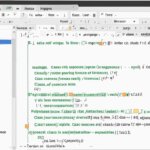Table of Contents
Object-oriented programming (OOP) is a fundamental programming paradigm used by nearly every developer in their career. OOP is the most popular programming paradigm for software development and is taught as the standard way to code in most educational programmes. OOP is based on the concept of classes and objects, which help structure a software programme into reusable code blueprints. A class is an abstract blueprint that creates more specific objects with defined attributes and methods. Objects are instances of classes and can have unique values for their properties. OOP brings various benefits to software engineering, including modularity, reusability, and increased security through encapsulation. Understanding the structure of OOP programmes involves grasping the concept of classes, objects, methods, and attributes. Common object-oriented programming languages include JavaScript, C++, Java, and Python.
Object-oriented programming (OOP) is a programming paradigm that relies on the concept of classes and objects. It is used to structure a software programme into reusable code blueprints (classes) that are used to create individual instances of objects. OOP languages, such as JavaScript, C++, Java, and Python, allow for both procedural and object-oriented programming styles. A class is an abstract blueprint that defines the attributes and methods for creating objects. Objects are instances of classes and can have unique values for their properties. Encapsulation is a key principle of OOP, which means that the internal state of objects is kept private, and other objects can only interact with them through defined methods. This helps in isolating and protecting sensitive information within the programme. OOP provides a structured approach to software development and allows for easier code maintenance and reuse.
The building blocks of Object-Oriented Programming (OOP) include classes, objects, methods, and attributes. Classes are user-defined data types that act as blueprints for creating objects. They define the structure and behaviour of the objects. Objects, on the other hand, are instances of classes and represent specific examples of the abstract class. They contain data stored in attributes and perform actions through methods. Methods are functions defined within a class that describe the behaviours of an object. They can modify, update, or delete data and perform specific actions. Attributes are the information that is stored in an object’s attributes field and define the state of the object. They represent the data associated with an object. Understanding these building blocks is essential for creating and working with objects in an object-oriented programme.
What is Object-Oriented Programming?
Object-Oriented Programming (OOP) is a programming paradigm that revolves around the concept of classes and objects. It serves as a way to structure software programs into reusable code blueprints (classes) that can then be used to create multiple instances of objects. OOP allows developers to organize their code in a more modular and efficient manner, promoting code reuse and maintainability.
OOP languages such as JavaScript, C++, Java, and Python support both procedural and object-oriented programming styles. However, the focus of OOP lies in creating classes and defining their attributes and behaviors, which can then be instantiated as objects.
A class acts as an abstract blueprint that outlines the properties and methods that objects created from that class will have. Objects, on the other hand, are the instances of those classes and represent specific examples of the abstract class, each with its unique values and states.
One of the key principles of OOP is encapsulation, which ensures that the internal state of objects is kept private. Encapsulation allows objects to interact with one another through defined methods, safeguarding sensitive information within the program.
In summary, Object-Oriented Programming provides a structured approach to software development. By utilizing classes and objects, developers can write code that is modular, reusable, and easier to maintain. Encapsulation further enhances code security, protecting important data from unauthorized access. Through OOP, programmers can build robust and scalable applications that adhere to best coding practices and promote efficient development processes.
Building Blocks of OOP
In object-oriented programming (OOP), the essential building blocks are classes, objects, methods, and attributes.
Classes serve as user-defined data types that act as blueprints for creating objects. They define the structure and behavior of the objects, providing a template for their creation.
On the other hand, objects are specific instances of classes, representing tangible examples of the abstract class. They contain data in the form of attributes and execute actions through methods.
Methods, which are functions defined within a class, describe the behaviors of an object. They enable manipulation, updates, and deletions of data, as well as the execution of specific actions.
Attributes, on the other hand, store information within an object’s attributes field and define its state. They represent the data associated with the object, providing it with unique characteristics.
An understanding of these building blocks is crucial for effectively creating and working with objects in an object-oriented program, enabling developers to design modular and reusable code.
FAQ
What is object-oriented programming?
Object-oriented programming (OOP) is a programming paradigm that relies on the concept of classes and objects. It is used to structure a software program into reusable code blueprints (classes) that are used to create individual instances of objects. OOP languages, such as JavaScript, C++, Java, and Python, allow for both procedural and object-oriented programming styles.
What are the benefits of object-oriented programming?
Object-oriented programming brings various benefits to software engineering. It offers modularity, allowing developers to break down their code into smaller, reusable components (classes) that can be easily maintained and extended. OOP also supports reusability, as objects can be created from existing classes. Additionally, OOP provides increased security through encapsulation, which keeps the internal state of objects private and allows interaction only through defined methods.
What are the building blocks of object-oriented programming?
The building blocks of object-oriented programming include classes, objects, methods, and attributes. Classes act as blueprints for creating objects and define their structure and behavior. Objects are instances of classes and represent specific examples of the abstract class. Methods are functions defined within a class that describe the behaviors of an object. Attributes are the data stored in an object’s attributes field and define the state of the object.
Which programming languages support object-oriented programming?
Object-oriented programming can be implemented in various programming languages. Some popular languages that support object-oriented programming include JavaScript, C++, Java, and Python. These languages provide the necessary syntax and features to define classes, create objects, and implement the principles of object-oriented programming.













